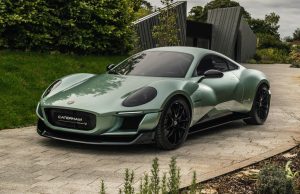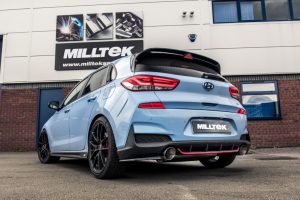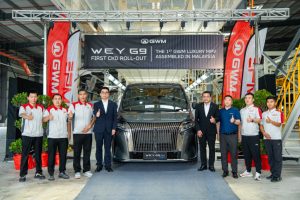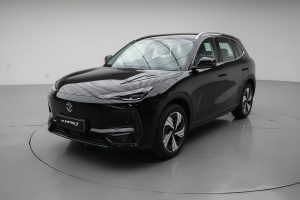After having driven and tested a swarm of SUVs, it’s good to be sitting a few pegs lower to the asphalt in the next test car.
The Hyundai Ioniq 6 sedan answered that call.
The fully imported Ioniq 6 rolled into Malaysia in July 2023 with two top variants.
Less than two month later, Hyundai expanded the line-up to four, bringing in lower-priced versions to make it available to a wider range of customers.
Hyundai obviously wants the Ioniq 6 to play in the premium league with prices ranging from RM220,000 to RM320,000.
With the exception of the top model variant which is all-wheel drive with two electric motors, the rest of the Ioniq 6 range comes packing a single motor in the rear axle.

The Max AWD, Max RWD, Plus RWD and Lite RWD retail for RM319,888, RM289,888, RM249,888 and RM219,888 respectively.
Hyundai and its affiliate Kia have been on a roll in recent years, producing high quality cars with eye-catching designs that have won them numerous awards.
The Ioniq 6 was the 2023 World Car of the Year and collected two more awards for its design and powertrain. The Ioniq 5 was the World Car a year before, and this year it was Kia’s turn and its EV9 to grab that brand-boosting accolade. All in all, a great few years for the Koreans.
All these award winners also have something in common — they use the same Electric-Global Modular Platform (E-GMP) and support multi (400/800V) rapid charging system and Vehicle-to-Load (V2L) functionality.
With 11kW AC charging, it takes about 7 hours to go from 0-100%. Using a 350kW DC charger to charge from 10-80% is only 18 mins, while a 50kW DC charger stretches it to 73 mins.

The Hyundai Ioniq 6’s design is a marked departure from conventional automotive aesthetics, featuring a sleek, streamliner silhouette inspired by 1930s aero efficiency.
While the front half of the tear-dropped car is fine, it’s the back half that either makes one love it — or not.
The swoopy rear has been likened to that of the Porsche. The Ioniq 6 has dual spoilers with the upper one broad and horizontal and is reminiscent of the whale tail of the 1970s Porsche 911.
The exterior lighting is particularly noteworthy, with Parametric Pixel-inspired headlamps and tail lights that add a futuristic touch to its overall design.

The full-length light bar at the rear amplifies this modern approach. Even the side mirrors come with signal lights with the square pixel lighting.
The overall lighting package gives the Ioniq 6 a signature look that is sophisticated and instantly recognisable.
Its low-slung profile and elongated shape are not just distinctive but functionally crafted to enhance aerodynamic efficiency, boasting an impressive drag coefficient of just 0.21. That’s much better than the 0.28 of the blocky Ioniq 5.
The Ioniq 6’s shape thus contributes to its performance and range efficiency.
In fact, the Max RWD test unit has the longest range of the four Ioniq 6s.

At 614km, it is also one of the few electric cars with one of the longest range. And some drivers have reportedly wrung a range close to that number, with just enough electrons left to get to the next charger.
However, it’s generally a good idea to manage your expectations; real-world range would probably be around 520km after discounting 15% from the official figure for a sensible operating margin.
Factors like driving style, heavy traffic, lugging a lot of weight, ascending hills or hot/cold weather all conspire to reduce range.

The cabin is spacious and minimalist. Anchoring the space is a cockpit equipped with dual 12.3-inch screens that look more refined than those of the Ioniq 5 with its large bezels.
The twin displays feature the instrument cluster and infotainment system, providing a seamless and high-tech user interface, complemented by physical buttons below for quick access to air-cond controls and volume.
Hyundai’s touchscreen infotainment system includes connectivity features like wired Apple CarPlay and Android Auto plus a host of Hyundai’s proprietary smart vehicle functions, making it both intuitive and versatile for driver and passengers alike.

Both ends of the dash looked oddly blank, however. That’s because OLED displays for the optional digital side cameras are supposed to be there in markets where they are allowed (Note: Malaysia allows for such cameras as seen in the Kia EV9 and Lotus Eletre).
Door window switches are grouped in the centre console like in classic BMWs; that’s to give the doors a cleaner look, says Hyundai.
Pixel lighting replaces the “H” emblem on the steering wheel and is used to enhance driver-car connection signalled by different light colour combinations and sequences.
The flat floor, a typical benefit of EV platforms, enhances the feeling of space, making the interior feel more akin to a lounge than a traditional car. There’s also ambient lighting allowing occupants to customise the cabin’s atmosphere to their preference.

Front seats are comfortable and supportive, and one sits low and snug. The front passenger seat has side button controls to allow the passenger behind to push it forward to increase rear space.
Rear seats are angled back and passengers sit deep in so there’s plenty of leg and elbow room but headroom may be limiting for tall passengers on account of the sloping roof.
At 401l, boot space is fairly large but not class-leading, and back seats can fold 60:40 to enlarge storage space. A 45l frunk is also standard in the RWD variants.
Like most EV makers nowadays, Hyundai likes to talk up its use of sustainable materials, including eco-processed leather for seats, bio TPO skin (dashboard), bio PET fabric (headliner), bio paint sourced from vegetable oils (doors) and recycled fishing nets (carpets).

The Ioniq 6 has earned a maximum five-star safety rating from Euro NCAP, so that means it bristles with advanced safety features to keep you out of trouble.
The seven airbags onboard includes a front-centre airbag and the standard Hyundai SmartSense suite of active safety systems comprises, among others, lane keeping assist; forward collision-avoidance assist; smart cruise control with stop & go; rear blind-spot collision-avoidance assist; forward collision-avoidance assist; and surround view monitor.

The car is equipped with a clever remote smart parking assist feature, enabling the driver to control the vehicle’s forward and backward movement from outside using the key fob.
Speaking of the key fob, it looks like it belongs in a budget car with its plasticky appearance; Hyundai should really consider making it as premium as the car it is paired with.

Equipped with a 77.4kWh Li-ion battery, the Ioniq 6’s rear motor delivers 168 kW/225hp and 350Nm of torque.
This setup propels the sedan from 0 to 100kph in a brisk 7.4 seconds. However, it’s slower than some Chinese electric vehicles that can be had for less money.
The Ioniq 6 features four driving modes — Eco, Normal, Sport, and Snow — easily adjustable via a knob on the steering wheel. This allows drivers to tailor the vehicle’s performance to a variety of driving conditions and personal preferences.
In urban areas, the Ioniq 6 excels with its light steering and the almost instant response from the electric motor.

The vehicle also offers multiple brake regeneration settings, including one-pedal driving that simplifies movement around town and contributes to driving comfort.
Because of its generally quiet powertrain, there is some noticeable tyre and wind noise at higher speeds.
The suspension of the Ioniq 6, while firm, effectively mitigates most road imperfections, ensuring a ride that is both smooth and comfortable.
It takes corners with zest and feels planted while doing so, thanks to the low centre of gravity.
By the time we handed back the Ioniq 6, we managed to record an energy consumption of 14.8 kWh/100km, which firmly marks the Ioniq 6 as an energy efficient car.

Whether used for urban commuting or for long trips out of town, the Ioniq 6 is in its element, making it a versatile pick for many drivers.
Performance and comfort come together in a tidy package that is attractive.
Hyundai is counting on its high brand equity to overcome resistance to its asking prices especially with a growing number of EV players entering the market.
For those who can pony up the cash, this is a car to satisfy the need to stand out from the crowd.
SPECIFICATIONS
Hyundai Ioniq 6 Max RWD
Electric motor: Permanent Magnet Synchronous Motor, single-motor, rear-wheel drive
Maximum power: 168kW
Maximum torque: 350Nm
Battery: 77.4kWh, Lithium-ion Polymer
Range: Up to 614km (WLTP)
Charging Time (0%-100%): 7.1 hours (AC:11 kW)
Rapid Charging Time (10% - 80%): 18 minutes (DC: 350kW) / 73 minutes (DC: 50kW)
Acceleration (0-100kph): 7.4 seconds
Top speed: 185kph
Features: 18-inch wheels, tilt and telescopic steering, front MacPherson struts, rear multi-link, dual LED projection headlamps, leather seats, powered front seats with lumbar support, Bose 8-speaker sound system, Bluetooth, Android Auto/Apple CarPlay, paddle shifters (Regenerative Braking Control) / i-Pedal; Smart Power Tailgate, Head Up Display (HUD), wireless phone charging, 1 x USB Type-A, 4 x USB-C, Automatic Light Control and wipers, Vehicle to Load (V2L @ 3.6kW)
Safety and assistance features: Seven airbags, Hill-Start Assist Control (HAC), Multi-Collision Brake (MCB), Electric Parking Brake (EPB), Blind-Spot Collision-Avoidance Assist (BCA) - Rear, Lane Keeping Assist (LKA) - Line/Road-Edge, Forward Collision-Avoidance Assist (FCA) - Car/Pedestrian/Cyclist, Highway Driving Assist 2 (HDA 2); Smart Cruise Control with Stop & Go, Manual Speed Limit Assist (MSLA), Forward Collision-Avoidance Assist 2 (FCA 2), Remote Smart Parking Assist 2 (RSPA 2); Parking Collision-Avoidance Assist (PCA) - Reverse/Forward/Side, Surround View Monitor, Rear-View Camera, Tyre Pressure Monitoring System,
Manual Speed Limit Assist (MSLA), Forward Collision-Avoidance Assist 2 (FCA 2), Remote Smart Parking Assist 2 (RSPA 2)
Price: RM289,888 (on-the-road before insurance)
Warranty: 8-year or 160,000km (whichever is first) battery warranty; 2-year or 50,000km (whichever is first) vehicle warranty
Optional vehicle warranty: Extra RM10,000 and upgradable to five years or 100,000km (whichever is first), and attached to this is three years or 50,000km (whichever is first) of free service
READ MORE: We also drive Hyundai Ioniq 6 Max AWD








































